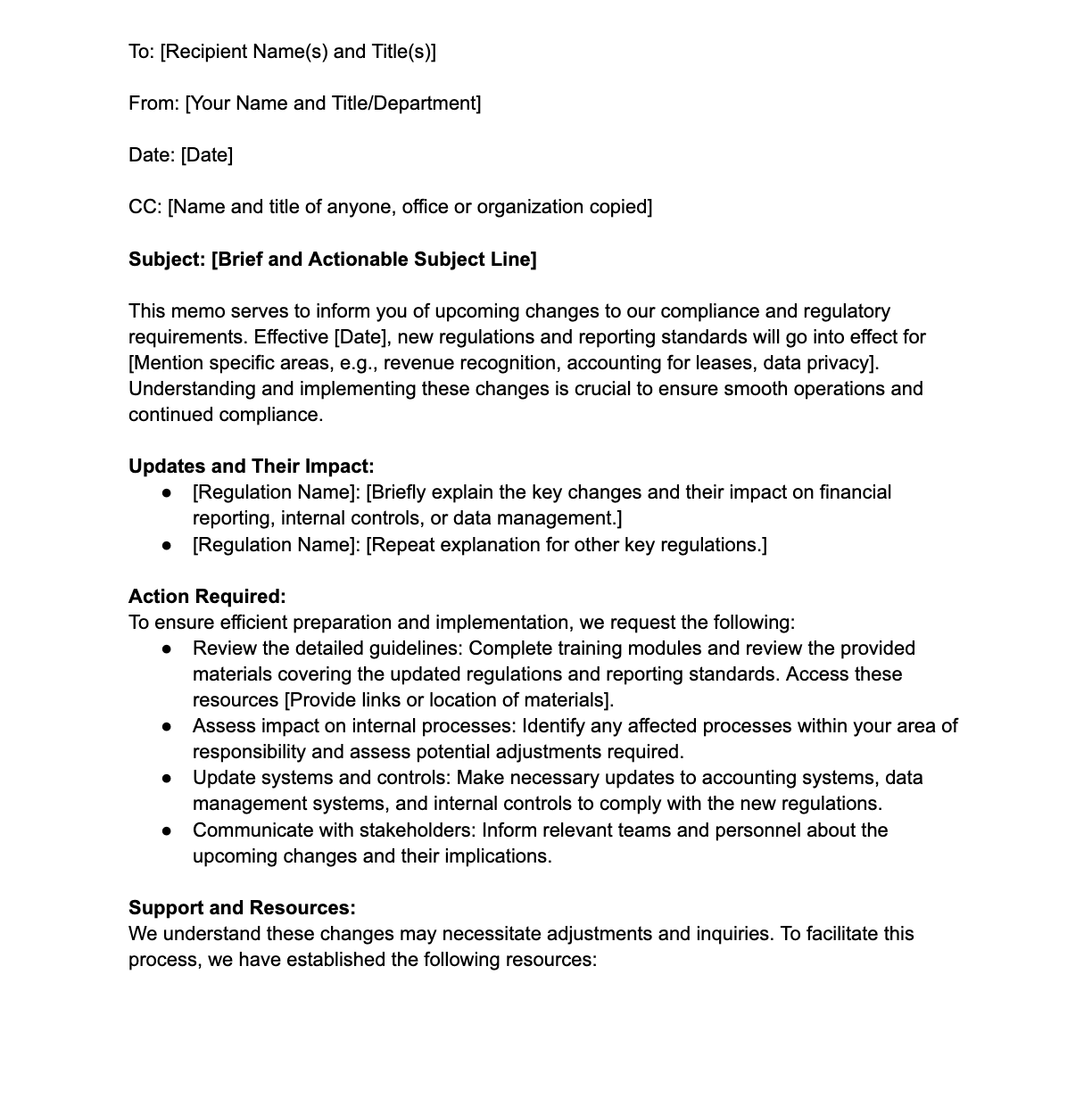In addition to critical hard skills like data analysis, financial reporting, accounting balancing, etc., communication is among the most beneficial soft skills accounting firm owners should possess.
Clear and concise communication is the bedrock of building strong relationships with clients, employees, and other stakeholders. By honing this skill, you can manage conflicts, ensure smooth operations, and boost your accounting business’s reputation.
Communicating well is also important when writing an accounting memo. This is because the recipient must easily understand and digest it. Unfortunately, many accountants find it difficult to write an effective memo because they lack the necessary communication skills and writing experience.
And so in this article, we share how to write a memo, along with a free template you can use.
What Is an Accounting Memo?
An accounting memo or memorandum is a document that shares important financial information with clients and employees.
Instead of relying solely on verbal or informal communication methods like casual conversations or ad-hoc emails, use written memos as they offer or a formalized way to communicate financial information, updates, or recommendations. You can also refer back to them, allowing for easy reference, clarity, and accountability.
Sample of an accounting memo
When do you need to use an Accounting Memo?
Some common scenarios where you might need to use an accounting memo include:
- When developing budgets, forecasts, or financial plans. You should communicate budgetary guidelines, assumptions, targets, and allocation methodologies to relevant stakeholders via memos.
- When there are changes in accounting policies, procedures, or internal controls, clients or staff have to be aware of.
- When you need to share new financial insights or analyses to inform decision-making with team members.
- After an internal or external audit, accounting memos may be necessary to summarize audit findings, recommendations, and management responses to facilitate corrective actions.
- To explain complex financial concepts or accounting standards to staff members or clients.
Key Components of a Compelling Accounting Memo
1. Header
This is the first section of an accounting memo. It appears at the top of the document and is important because it guarantees your memo reaches the intended recipient. It can also help you track the communication timeline. The header section includes the following fields:
- To: the primary recipient(s) of the memo.
- Include their names and titles.
- From: The sender of the memo.
- Include your name and title or department.
- The date you’re sending the memo.
- CC: Include any additional recipients you want to keep in the loop.
2. Subject line
The subject line helps the recipient understand what the memo is about at a glance and serves as a reference point for future retrieval. A good subject line should grab attention and summarize the purpose of the communication.
3. Introduction
The introduction sets the tone for the rest of the document. It should provide a brief overview of the memo’s purpose and what recipients can expect to find in it. To create an introduction that piques the reader’s interest and encourages them to keep reading, start with relevant statistics or facts, a compelling statement, a thought-provoking question, a story, current news/events, or quotes from notable sources.
4. Discussion
This is the core of the memo. It is where you present the financial information, policies, procedures, or other relevant details supporting your message. Remember to maintain a professional tone and write to the reader’s familiarity with financial concepts.
5. Analysis
Like the discussion, the analysis section is also part of the document’s main body. It allows you to interpret the financial data to find trends or patterns relevant to the topic of the memo, identify insights arising from the data, and offer recommendations based on your findings. You can use charts, tables, or graphs to illustrate your analysis and enhance the reader’s understanding.
6. Conclusion
This is the final section and your last opportunity to leave a lasting impression on the reader. Here, summarize the key points discussed in the memo and reiterate the main message.
7. Call to action (CTA)
Add a call to action encouraging the recipient to take the desired next steps. This could be a request for feedback/input, confirmation of understanding, implementation of policies or specific changes, etc.
8. Thank you
Although this is optional, adding a “thank you” at the end is a respectful way to sign off. It expresses gratitude to the reader for their time, attention, and consideration.
9. Signatures
Sign off with your name, title, and contact information (if you want) to add credibility and accountability to the memo.
10. Attachments
You may also need to attach relevant documents such as financial reports, charts, or supporting data to aid comprehension or support points made in the memo. Label each attachment clearly and reference them within the memo where necessary.
Step-by-Step Guide for Writing an Accounting Memo
When composing a memo, follow the steps below.
Step 1: Define the purpose and audience
First, clarify the aim and objective of the memo. Then, identify the target audience, i.e., their specific needs, knowledge levels, and expectations. This will help you tailor the memo to suit the audience so they understand the content.
For example, say you just got a new practice management software for your firm that you need your staff to know about. The purpose of the memo will be to announce the implementation of this new system. And the audience may be your employees, including partners, managers, or staff members.
Step 2: Research
Next, gather all the necessary information to include in your memo. Analyze the information and ensure it aligns with the purpose and audience you defined in the first step.
Cross-check all facts to see that they are accurate and up-to-date. Collect reputable sources to support your statements and add credibility to the document.
Step 3: Organize your information
Once you have gathered and validated all the information, you have to organize it using the structure we discussed earlier, i.e., header, subject line, introduction, discussion, analysis, conclusion, CTA, thank you, and signature.
Step 4: Use concise and clear language
Write in a clear, concise, and easily understandable manner. Avoid jargon or technical terms that may confuse the reader. Aim for a professional and engaging tone throughout the memo to keep the reader interested and feeling confident about the topic.
Step 5: Create your draft
Now, draft your accounting memo. Start by creating the content based on the established structure and to the identified audience. Use headings, subheadings, bullet points, and other formatting techniques to make the memo visually appealing and aid clarity. See that the content is logical and flows smoothly from one section to another.
Step 6: Proofread carefully
Review the draft for clarity, coherence, and accuracy of information. Also, check for grammatical or spelling errors. You can use tools like Grammarly to edit and improve the overall quality.
Step 7: Share the memo
After verifying your memo is error-free and attaching relevant documents, it’s time to share it with the intended recipients. Distribute it through appropriate channels like emails, printing physical copies, or internal communication platforms. Remember to CC the additional receipts. You can also request confirmation of receipt so you know if they’ve received the memo and understand it.
Step 8: Lean on templates
Using templates to streamline the memo-writing process is beneficial if you send memos often. Templates save time, ensure consistency, help you cover all necessary sections, and maintain a professional layout. Below is a free basic template you can use.
Free Accounting Memo Template
Free Accounting Memo Template
Copy and paste the template below into a document, or just download and save it somewhere easily accessible.
To: [Recipient Name(s) and Title(s)]
From: [Your Name and Title/Department]
Date: [Date]
CC: [Name and title of anyone, office or organization copied]
Subject: [Brief and Actionable Subject Line]
This memo will inform you of upcoming changes to our compliance and regulatory requirements. Effective [Date], new regulations and reporting standards will go into effect for [Mention specific areas, e.g., revenue recognition, accounting for leases, data privacy]. Understanding and implementing these changes is crucial to ensure smooth operations and continued compliance.
Updates and Their Impact:
- [Regulation Name]: [Briefly explain the key changes and their impact on financial reporting, internal controls, or data management.]
- [Regulation Name]: [Repeat explanation for other key regulations.]
Action Required:
To ensure efficient preparation and implementation, we request the following:
- Review the detailed guidelines: Complete training modules and review the provided materials covering the updated regulations and reporting standards. Access these resources [Provide links or location of materials].
- Assess the impact on internal processes: Identify any affected processes within your area of responsibility and assess potential adjustments required.
- Update systems and controls: Make necessary updates to accounting systems, data management systems, and internal controls to comply with the new regulations.
- Communicate with stakeholders: Inform relevant teams and personnel about the upcoming changes and their implications.
Support and Resources:
We understand these changes may necessitate adjustments and inquiries. To facilitate this process, we have established the following resources:
- Dedicated FAQs: Access frequently asked questions and detailed explanations on the company intranet [Provide link].
- Training sessions: Attend in-person or online training sessions offered by the Finance department [Provide schedule and registration details].
- One-on-one consultations: Schedule individual consultations with the compliance team for specific questions or concerns [Provide contact information].
Timeline and Compliance:
Adherence to these regulations is mandatory and carries potential penalties for non-compliance. Our target is to fully implement the updated regulations by [Date]. Please prioritize these tasks and seek assistance if needed.
We appreciate your cooperation and commitment to maintaining our strong compliance record. Do not hesitate to contact the Finance department or Compliance team if you have any questions or concerns.
Thank you.
[Your Signature]
[Your Title]
Attachments:
- Regulatory Update Summary
- Training Schedule and Registration Link
- Compliance Team Contact Information
Additional Tips for Writing a Concise Memo
- Use visuals (e.g., charts, graphs) to enhance your memo.
- Keep your memo to one page and your sentences/paragraphs short.
- Get feedback from a colleague before sending your memo.
- Avoid unnecessary details or fluff that could dilute the main message.
- Use bullet points and numbered lists when presenting a series of items or points.
Conclusion
Creating an effective memo is not complicated if you follow the guidelines outlined here and the memo we provided. With a good memo, you can share important information effectively with your staff and your audience and convey important information effectively.
To further improve efficiency in your firm, you need an accounting practice management software like Financial Cents. Our tool makes it easy to manage client work and streamline your process so you can meet deadlines and scale your firm.







